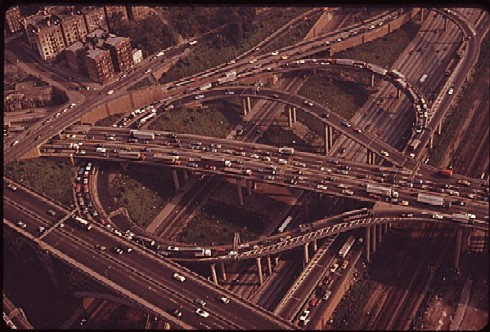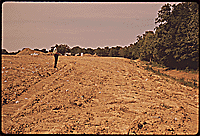National Trends
Legislation
The U.S. Housing Act of 1949 "established an urban redevelopment program based on the idea of slum clearance. Title I of the act authorized the federal government to make loans to cities to acquire blighted areas as well as 'write-down' grants to help cover the difference between the cost of slum land and its redeveloped value. The law also contained a large endorsement of public housing in Title III, which authorized federal loans and grants to build 810,000 new public housing units over the next six years. Although the law did not specifically tie public housing to urban redevelopment projects, it did provide that sites be 'predominantly residential' either before or after redevelopment. The clear implication was that projects would involve re-housing slum dwellers either on the site or elsewhere.” [1] The Housing Act of 1954, which coined the phrase urban renewal "specified that voluntary repair and rehabilitation could be adopted instead of or along with clearance and rebuilding schemes. The law required a 'workable program' for any urban renewal loans or grants. To promote the development of housing for urban renewal sites and displaced and low-income families, it contained the new sections 220 and 221 of the National Housing Act as special mortgage insurance programs" [2]. Read more of Alexander von Hoffman's "Enter the Housing Industry, Stage Right: A Working Paper on the History of Housing Policy." (PDF)
For further information regarding urban redevelopment legislation see:
- Dr. Yvonne Scruggs "HUD's Stewardship of National Urban Policy: A Retrospective View." (PDF)
- Arnold R. Hirsch's "The Last and Most Difficult Barrier: Segregation and Federal Housing Policy in the Eisenhower Administration, 1953-1960." (PDF)
- D. Bradford Hunt's "How Did Public Housing Survive the 1950s?"
- See a timeline of the U.S. Department of Housing and Urban Development, 1930-2010
- Read President Harry S. Truman's Annual Message to the Congress on the State of the Union, January 05, 1949.
Further Keyword Research Suggestions:
- U.S. Housing Act of 1949
- Housing Act of 1954
- National Housing Agency
- Urban Renewal Agency
- Urban Redevelopment Agency
- President Lyndon Johnson's War on Poverty
- Civil Rights Act
- Housing and Urban Development Act (1968)
- New Communities Act of 1968
- Housing and Community Development Act of 1974
- Housing and Home Finance Administration
- National Association of Real Estate Boards (after 1972 known as National Association of Realtors)
- Urban Land Institute
- National Association of Home Builders
- Subcommittee on Housing and Urban Redevelopment of the Senate Special Committee on Post-war Economic Policy and Planning, Berman v. Parker

Transportation
Urban Expressways
In the June 1947 issue of The American City, the Bureau of Public Roads Chief Thomas H. MacDonald made his case for the construction of urban expressways. He stated that "in most instances, routes selected for expressways, as they approach the center of the city, pass through 'blighted' sections where property values are low, and most of the buildings are of the type that should be torn down in any case, to rid the city of its slums. [Expressways were only partly about moving traffic] these roads, developed with vision, will do much to stop the decay of our cities at their centers and prevent the attendant decrease in property values. They will help to check the accelerated growth of blighted areas, which are the product of traffic congestion, lack of planned land use, and the failure to create attractive opportunities of private capital." To find out more about how the Interstate System was intended to solve the urban problems it is now blamed for causing, see Richard F. Weingroff's "Designating the Urban Interstates" and "The Genie in the Bottle: The Interstate System and Urban Problems, 1939-1957."
Urban Transportation Planning
"Urban transportation planning in the United States has always been conducted by state and local agencies. This is entirely appropriate since highway and transit facilities and services are owned and operated largely by the states and local agencies. The role of the federal government has been to set national policy, provide financial aid, supply technical assistance and training, and conduct research. Over the years, the federal government has attached requirements to its financial assistance. From a planning perspective, the most important has been the requirement that transportation projects in urbanized areas of 50,000 or more in population be based on an urban transportation planning process. This requirement was first incorporated into the Federal-Aid Highway Act of 1962.
Other requirements have been incorporated into federal legislation and regulations over the years. Many of these are chronicled in this report. At times these requirements have been very exacting in their detail. At other times, greater flexibility was allowed in responding to the requirements. Currently, the emphasis is on increasing state and local flexibility in planning implementation, and in making the planning process more inclusive for all groups and individuals.
Over the years, a number of federal agencies have affected urban transportation planning. The U.S. Bureau of Public Roads (BPR) was part of the U.S. Department of Commerce when the 1962 Highway Act was passed. It became part of the U.S. Department of Transportation (DOT) upon its creation in 1966 and its name was changed to the U.S. Federal Highway Administration (FHWA). The federal urban mass transportation program began in 1961 under the U.S. Housing and Home Finance Administration, which became the U.S. Department of Housing and Urban Development in 1965. The federal urban transit program was transferred to DOT in 1968 as the U.S.
While highway departments were placing major emphasis on arterial routes, city street congestion was steadily worsening. It was in this atmosphere that the Committee on Urban Transportation was created in 1954. Its purpose was, "to help cities do a better job of transportation planning through systematic collection of basic facts ... to afford the public the best possible transportation at the least possible cost and aid in accomplishing desirable goals of urban renewal and sound urban growth" (National Committee, 1958-59)." Learn more about "Urban Transportation Planning in the United States: An Historical Overview." See also Raymond A. Mohl's "The Interstates and the Cities: Highways, Housing, and the Freeway Revolt." (PDF)
In 1960, a conference was held through the National Academy of Sciences to review "the nature and ramifications of transportation activities in the United States and to prepare suggestions for improving, through research, national capabilities for dealing with transport problems." Read their "Transportation Design Considerations" which are selections from the proceedings of the Transportation Research Conference.
 |
Planning
City planning is a process of planning for the improvement of urban centers in order to provide healthy and safe living conditions, efficient transport and communication, adequate public facilities, and aesthetic surroundings. Planning that also includes outlying communities and highways is termed regional planning [3]. Learn about regional planning of the 1960s in Robert Fishman's "The Death and Life of American Regional Planning" (PDF) or learn about city planning in Mel Scott's American City Planning Since 1890.
Life Magazine published an issue entitled "The U.S. City: Its Greatness is at Stake." Every year they published a double issue which focused on one particular subject that was topical and significant, and for 1965 they chose "the city."
The 100 Essential Books of Planning from the American Planning Association provides an excellent bibliography of the history of American planning. On their list for the 1960s include Martin Anderson's The Federal Bulldozer: A Critical Analysis of Urban Renewal, 1949-1962 which signaled "a turn away from the idealistic 'tear down and build new and better' approach to city planning. Anderson's early history of urban renewal detailed the mechanisms and legislation used to push the program forward, showing how its idealistic goals quickly gave way to destruction for its own sake."
For other primary resources, see Urbanization and Changing Land Uses: A Bibliography of Selected Resources, 1950-1958 which was compiled by Elizabeth Gould Davis, Hugh A. Johnson and Claude C. Haren and published by the U.S. Department of Agriculture in 1960.
 |
Web Links
Fishman, Robert. "The Death and Life of American Regional Planning." (PDF)
Hill, Amy. "Invitation to Mapping: How GIS Can Facilitate New Discoveries in Urban and Planning History.
(published in Journal of Planning History May 2010 - requires subscription)
H-Urban. A moderated, multi-disciplinary forum for discussion and dissemination of scholarship on urban history and urban studies.
In Motion: The African-American Migration Experience (The Schomburg Center for Research in Black Culture)
Journal of Planning History. Peer-reviewed and published quarterly,
focuses on the history of the city and regional planning, with particular emphasis on the Americas.
Journal of Urban History. Peer-reviewed and published bi-monthly, provides scholars and professionals with the latest research, analyses, and discussion on the history of cities and urban societies throughout the world.
Life in the Model City: Stories of Urban Renewal in New Haven (New Haven Oral History Project)
Longstreth, Richard. "The Difficult Legacy of Urban Renewal". (PDF)
Melosi, Martin V. "Automobile in American Life and Society: The Automobile Shapes the City".
Mohl, Raymond A. "Race and Housing in the Postwar City: An Explosive History."
Myers, Dowell and John Pitkin. "Demographic Forces and Turning Points in the American City, 1950-2040." (PDF)
Pattillo, Mary. Black on the Block: The Politics of Race and Class in the City (excerpt)
Remarks of Senator John F. Kennedy at Urban Affairs Conference, Pittsburgh PA 10-10-1960
Resistance and Relocation: Freeways and Contested Space in Omaha, 1958-1962 (Nicholas D. Swiercek, Univ. of Nebraska-Lincoln)
Scott, Mel. American City Planning Since 1890. (1971)
Teaford, Jon C. "Urban Renewal and Its Aftermath." (PDF)
U.S. Department of Housing and Urban Development (HUD)
von Hoffman, Alexander. "The Quest for a New Frontier in Housing." (PDF)
Notes
[1] von Hoffman, Alexander. "Enter the Housing Industry, Stage Right: A Working Paper on the History of Housing Policy." Joint Center for Housing Studies Harvard University. February 2008. http://www.jchs.harvard.edu/sites/jchs.harvard.edu/files/w08-1_von_hoffman.pdf
[2] von Hoffman.
[3] City Planning, https://web.archive.org/web/20130507022640/http://education.yahoo.com/reference/encyclopedia/entry/cityplan